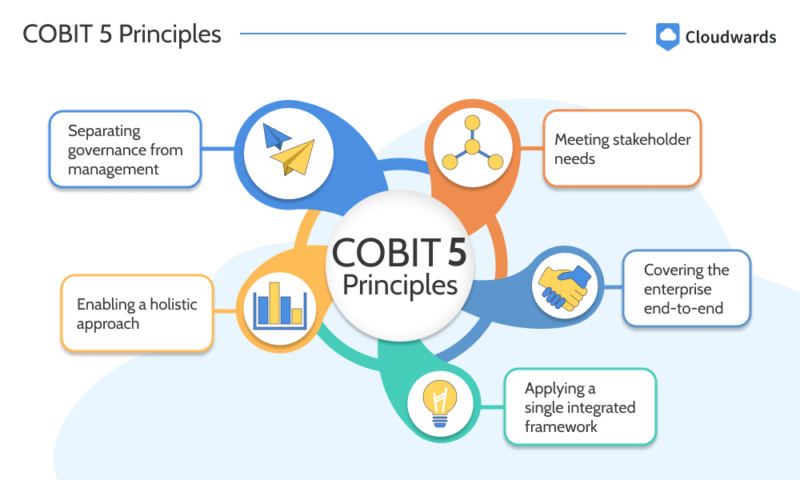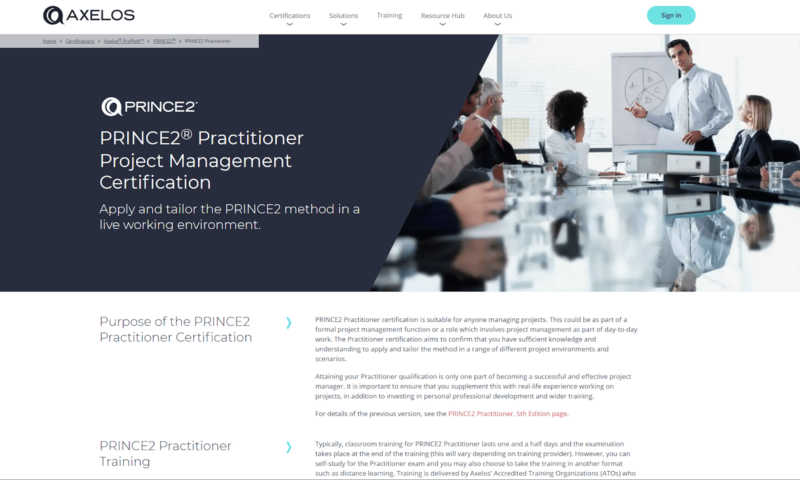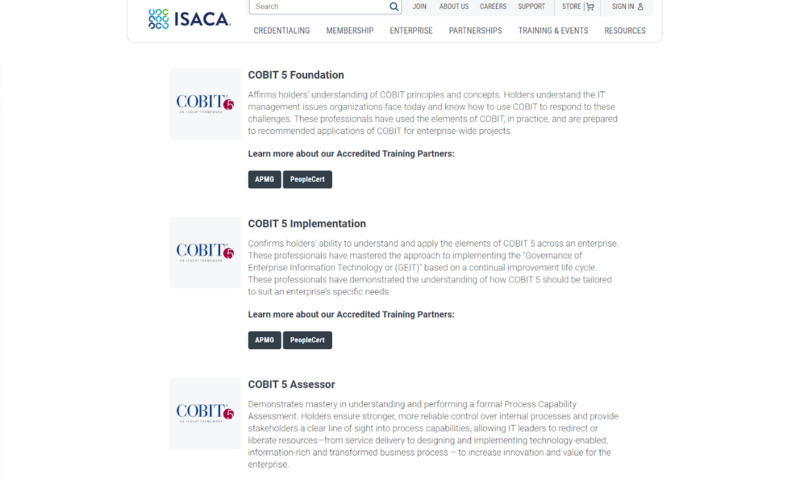- Meeting stakeholder needs
- Covering the enterprise end to end
- Applying a single integrated framework
- Enabling a holistic approach
- Separating governance from management
Facts & Expert Analysis About COBIT 5
- COBIT 5 certifications: ISACA offers four certifications, ranging from entry to master level, for those wishing to pursue an IT systems management career.
- A standalone framework: COBIT 5 can be used as a single integrated framework. However, it can also be integrated with other frameworks, such as ITIL and PRINCE2.
- Risk management: One of the main benefits of implementing COBIT 5 is enhanced risk management. By adopting a holistic approach, COBIT 5 forces leaders to consider every aspect of an operation and all decisions before moving ahead with a project.
Only well-managed IT departments can run smoothly, address the needs of stakeholders and meet regulatory compliance standards. This is where IT governance and management frameworks like COBIT 5 come into play. If you want to learn more about COBIT 5 and how the COBIT 5 principles can help your IT department succeed, read on.
\In order to implement the COBIT 5 principles in practice, we recommend using any of the best project management tools to keep track of tasks and processes. Furthermore, whether you want to install a new IT system in house or for a client, implement the best cloud storage or cloud-based backup services in your organization, or become proficient in IT risk management, the COBIT 5 framework and its five principles can help.
In this guide, we’ll explain what COBIT 5 is. We’ll also detail the COBIT 5 principles and explain how your IT systems can benefit from implementing them. If a career in IT management and governance interests you, we have you covered with a list of the most popular COBIT 5 certifications.
Show allLearn more about our editorial team and our research process.
What Is COBIT 5?
COBIT 5 is a unified framework that helps an organization’s IT department tackle risk management, achieve regulatory compliance and align IT strategies with strategic objectives. The framework provides globally recognized methods, IT processes, key concepts and analytical tools that help businesses reach operational efficiency objectives.
Meaning: What Does COBIT Stand For?
COBIT stands for “control objectives for information and related technology.” Organizations use this method to ensure IT assets are organized and deployed effectively.
What Are the Five Key Principles of the ISACA COBIT 5 Framework?
The five principles of the ISACA COBIT 5 framework are meeting stakeholder needs, covering the enterprise end to end, applying a single integrated framework, enabling a holistic approach and separating governance from management. Below, we’ll cover each core principle in detail.

Meeting stakeholder needs is vital in any framework, including other IT frameworks such as ITIL. Organizations should always put the needs of stakeholders first, as businesses can only succeed if stakeholder needs are met. This COBIT 5 principle focuses on negotiations, decision-making and resolving stakeholder conflicts while making IT governance decisions.
This principle also covers risk management. When interacting with stakeholders and determining their needs, one must decide which stakeholders will benefit from decisions and who might oppose them. All risks and issues should be documented and revisited often to ensure operations run smoothly.
Covering the enterprise from end to end forces organizations to take a holistic view of IT governance. Leaders are encouraged to examine processes, information, potential risks and the technology to be used to ensure all decisions made are in the company’s best interest. The four aspects of this approach are:
- Assigning responsibilities and roles to those best qualified
- Deciding upon the IT project scope
- Deciding what will work individually or collectively
- Creating value through governance
COBIT 5 champions the use of a single integrated framework, so organizations can quickly react to rapid changes in the IT landscape. IT managers must be able to quickly meet the demands of changing markets, stakeholders, clients, consumers and suppliers. Making decisions can be challenging if multiple methodologies are used.

an IT and enterprise governance framework.
COBIT 5 can be used with other IT management frameworks, such as ITIL, ISO27001, TOGAF and PRINCE2, if your organization demands extra layers of structure via systems and processes.
Still, if possible, COBIT 5 should be used as a single integrated framework so managers can use a standardized set of technical and non-technical terminology, and align all management and governance activities with one set of standards and rules.
At first glance, this principle appears similar to “cover the enterprise end to end.” However, that principle refers to IT governance, whereas COBIT 5 applies to the entire organization.
Organizations should do everything they can to enable a holistic approach so they can easily examine organization-wide structures and processes before making drastic changes. COBIT 5 uses enablers to determine whether governance and IT management decisions will be effective. The enablers, which are directed by objective and business goals, are:
- Processes
- Information
- Organizational structures
- Principles, policies & frameworks
- Business culture, ethics & behaviors
- Services, infrastructure & applications
When managers and project leaders consider the enablers, they can make informed decisions that advance a project and the organization at large. For example, when planning a project, leaders will decide on principles, processes, policies, information they will share and the frameworks they will use.
In addition, the organizational structure will be examined to ensure everyone knows who to contact for specific issues. Guidelines surrounding ethics and behaviors will be communicated. The IT system infrastructure and the services and applications to be used will be discussed, and team members with the right skills for the job will be selected.
COBIT 5 emphasizes separating governance practices, which cover planning, processes, risk management and creating value, from management, which covers IT systems deployment, maintenance and people. Projects run more smoothly when these elements do not depend on each other.
To do so, COBIT 5 employs the EDM (evaluate, direct and monitor) method to monitor governance practices. This ensures stakeholder needs are met and that objectives are evaluated and monitored for performance.
To ensure proper management of the activities defined in governance, COBIT 5 uses the PBRM (plan, build, run and monitor) technique to ensure activities run according to plan.
What Are the Benefits of COBIT 5 Processes?
Following a management and governance system like COBIT 5 can lead to many benefits. Below, we’ll cover what those using COBIT 5 can gain.
Better Risk ManagementCOBIT 5 can help organizations identify risks and prevent issues before they occur or right after they appear. By performing stakeholder analysis and adopting a holistic approach, managers can plan for potential issues that can arise from processes, organizational structures, people, behaviors, policies and frameworks.
COBIT 5 champions open and honest communication between cross-functional teams and stakeholders the same way Agile methodologies do. Open communication can break down barriers, align business needs and stakeholder goals, and increase efficiency through free-flowing information.
Those using COBIT 5 ensure all IT activities and decisions positively impact business and strategic goals while also meeting stakeholder needs. By creating detailed project scopes, adopting a single integrated framework and following the five COBIT principles, leaders can help ensure better outcomes.
Tips & Considerations for Implementing COBIT Principles
Implementing COBIT 5 can bring many benefits to an organization. However, the decision to adopt COBIT 5 shouldn’t be rushed. Changing from one framework to another can be jarring and can require a change manager to get everyone on board. You must also ensure your team understands the following key concepts:
- COBIT 5 objectives: Ensure managers understand most of the 40 objectives COBIT 5 uses to guide decisions. You can pick and choose which objectives best align with your business, but having no prior knowledge of them will only lead to disaster.
- Components of COBIT 5: Before adopting COBIT 5, consider your team’s components (structure and skills). If the team doesn’t possess enough knowledge of the COBIT 5 framework, they’ll struggle to work in the new environment.
- COBIT 5 domains: COBIT 5 uses domain classifications to discover objectives related to planning, building and monitoring IT systems. A thorough understanding of domains is required for COBIT 5 implementation to be successful.
- COBIT 5 goals cascade: The process used in COBIT 5 to explain how goals and organizational needs are linked is called a goals cascade. Managers must have a thorough understanding of how to link business needs and goals to be successful.
Is There a COBIT 5 Certification?
COBIT 5 is a complex IT framework. Fortunately, many training programs can help you familiarize yourself with this IT management method. ISACA currently offers four COBIT 5 certifications: COBIT 5 Foundation, COBIT 5 Implementation, COBIT 5 Assessor and Implementing the NIST Cybersecurity Framework Using COBIT 5.

COBIT 5 Foundation is an entry-level certification that shows you have a basic understanding of the COBIT 5 principles and concepts, and how to use them to respond to IT challenges. COBIT 5 Implementation shows that individuals have mastered the governance of enterprise information technology (GEIT) and can apply the COBIT 5 principles across enterprises.
Then, COBIT 5 Assessor demonstrates that you’re a COBIT 5 master and can provide stakeholders with insights into how the framework increases innovation and value. The Implementing the NIST Cybersecurity Framework Using COBIT 5 certification confirms your knowledge of NIST and how to apply it using COBIT 5.
Final Thoughts
Following the five principles of COBIT 5 can help IT departments identify risks, meet regulatory requirements, appease stakeholders and align business and IT needs. The framework can also help organizations implement globally recognized processes and analytical tools that can help them achieve success in the same way that other frameworks can, such as ITIL and PRINCE2.
Have you used the COBIT 5 framework? How does it compare to ITIL, TOGAF and PRINCE2? Are there other IT management frameworks that you’d like us to cover? Let us know in the comments. Thanks for reading.
FAQ: The COBIT 5 Principles Explained
- What Is the COBIT Framework?
COBIT 5 is a framework that helps an organization’s IT department identify risks, meet regulatory compliance and align IT strategies with strategic business objectives.
- What Are the Five Principles of COBIT 5?
The five principles of COBIT 5 are meeting stakeholder needs, covering the enterprise end to end, applying a single integrated framework, enabling a holistic approach and separating governance from management.
- Is COBIT 5 Outdated?
No, COBIT 5 is not outdated. This IT management framework is constantly being updated to meet the demands of modern IT requirements.
The post The Five COBIT 5 Principles Explained in 2024 appeared first on Cloudwards.
 7 months ago
40
7 months ago
40

